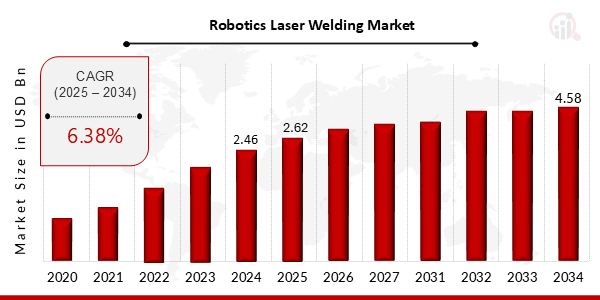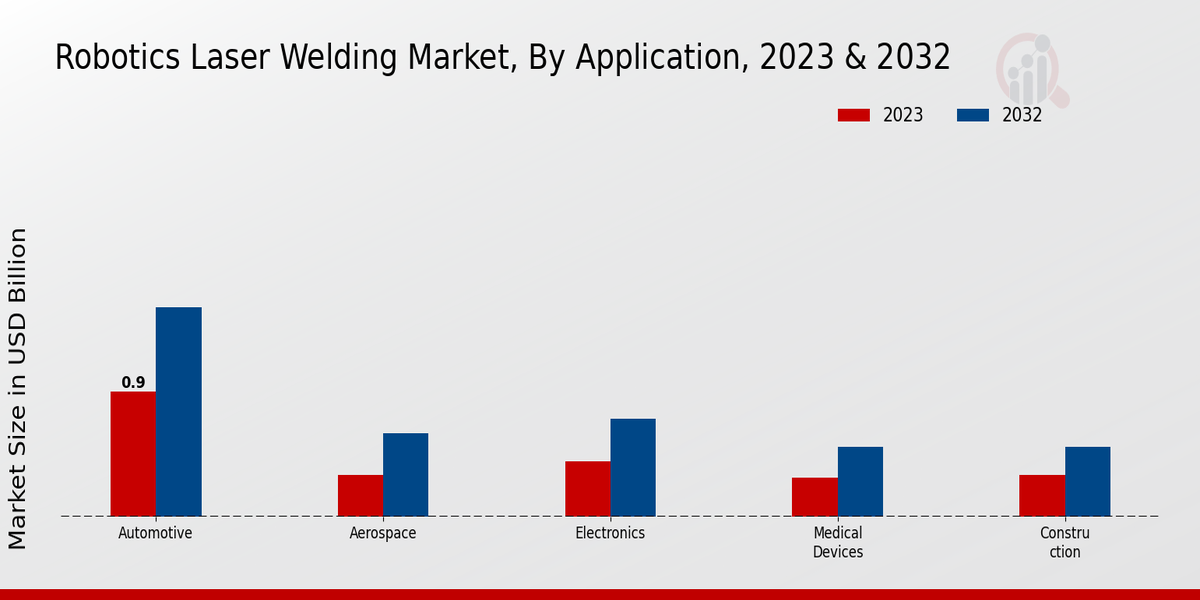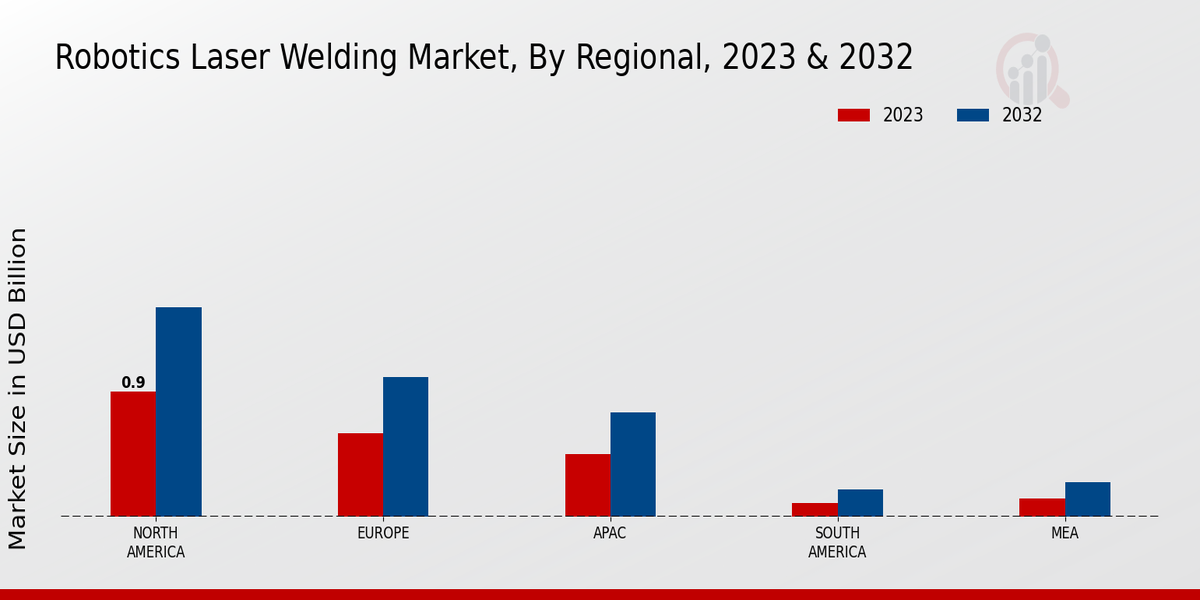Global Robotics Laser Welding Market Overview
Robotics Laser Welding Market Size was estimated at 2.46 (USD Billion) in 2024. The Robotics Laser Welding Market Industry is expected to grow from 2.62 (USD Billion) in 2025 to 4.58 (USD Billion) till 2034, exhibiting a compound annual growth rate (CAGR) of 6.38% during the forecast period (2025 - 2034).
Key Robotics Laser Welding Market Trends Highlighted
The Robotics Laser Welding Market is influenced by several key drivers, including the growing demand for automation in manufacturing processes. Industries are increasingly adopting laser welding technology due to its precision and efficiency, which help reduce production costs and time. As manufacturers look for ways to improve quality and consistency, the automation capabilities of robotics paired with laser welding are becoming vital. Additionally, the rise of sophisticated materials and the need for complex welding applications are pushing innovation in this sector, leading to advancements in robot design and laser technology. There are significant opportunities to be explored in sectors such as automotive, aerospace, and electronics, where high-quality welds are essential.The trend towards lightweight and high-strength materials, like aluminum and advanced composites, is creating new avenues for laser welding applications. Furthermore, the increasing focus on green manufacturing processes and sustainability drives the demand for efficient welding solutions. Companies can capitalize on this trend by integrating advanced robotics and laser systems to meet these evolving requirements while minimizing waste and energy consumption. In recent times, the robotics laser welding market has seen noteworthy advancements in technology. Innovations such as artificial intelligence and machine learning are being integrated into welding systems to enhance performance and adaptability.This trend allows for better quality control and real-time monitoring, increasing the overall efficiency of welding processes. Moreover, the growth of Industry 4.0 is transforming manufacturing by promoting connectivity among machines, enhancing data collection, and improving predictive maintenance. These developments signify a paradigm shift in how welding operations are conducted, making them more efficient and responsive to market demands.

Source: Primary Research, Secondary Research, MRFR Database and Analyst Review
Robotics Laser Welding Market Drivers
Technological Advancements in Laser Welding
The Robotics Laser Welding Market Industry is experiencing significant growth due to continuous technological advancements in laser welding processes. Innovations such as improved laser beam quality, automated systems, and advanced robotics have enhanced the efficiency and accuracy of welding operations. The integration of artificial intelligence and machine learning in robotic systems allows for real-time monitoring and adjustments during the welding process, further increasing productivity and quality.As manufacturers and industries seek greater precision and reduced cycle times, the demand for advanced laser welding solutions is projected to escalate. Enhanced automation in manufacturing processes reduces human error, minimizes downtime, and ultimately leads to cost savings. Additionally, as industries move towards automation to meet increasing production demands, the implementation of robotics within the welding sector becomes a critical focus.These advancements not only improve the speed and precision of welding applications but also open new opportunities in various sectors, including automotive, aerospace, and construction. As the Robotics Laser Welding Market Industry continues to evolve, further advancements in laser technologies and automation will likely drive market growth, attracting more investments and fostering innovation across the field.
Rising Demand for Automation in Manufacturing
In recent years, there has been a notable shift towards automation in manufacturing processes, significantly influencing the Robotics Laser Welding Market Industry. Industries are increasingly recognizing the benefits of adopting automated solutions to improve operational efficiency, enhance product quality, and lower costs. Robotics laser welding plays a pivotal role in this transformation, enabling manufacturers to optimize their production lines and achieve higher output rates.By integrating robotics into welding processes, companies can minimize labor costs, reduce scrap rates, and enhance worker safety. The growing necessity for precision and reproducibility in manufacturing processes further propels the adoption of robotic laser welding technologies, leading to sustained market growth in the coming years.
Increased Use of Laser Welding in Diverse Applications
The versatility of laser welding technology has led to its increased adoption across various industries within the Robotics Laser Welding Market Industry. Applications range from automotive and aerospace to electronics and medical devices, reflecting the broad applicability of laser welding. As industries seek advanced techniques for joining materials, laser welding provides distinct advantages, such as minimal heat-affected zones and the ability to weld dissimilar materials.This versatility not only enables manufacturers to enhance product quality but also fosters innovation in product design and functionality. The diverse application spectrum is expected to drive demand for robotic laser welding solutions, contributing to the continued growth and development of the market.
Robotics Laser Welding Market Segment Insights:
Robotics Laser Welding Market Application Insights
The Robotics Laser Welding Market, valued at 2.18 USD Billion in 2023, is witnessing significant developments across its various applications. This market comprises multiple sectors, particularly Automotive, Aerospace, Electronics, Medical Devices, and Construction, each playing a unique role in driving overall market growth. The Automotive sector is the dominant player, holding a valuation of 0.9 USD Billion in 2023, and is projected to reach 1.5 USD Billion by 2032, showcasing majority holding and significant demand due to the industry's ongoing shift towards automation and precision engineering.The Aerospace sector, valued at 0.3 USD Billion in 2023 and expected to grow to 0.6 USD Billion by 2032, benefits from advanced welding techniques that enhance aircraft safety and efficiency. In the Electronics segment, the market is currently valued at 0.4 USD Billion, with an anticipated growth to 0.7 USD Billion, highlighting the increasing need for high-quality assembly processes in the rapidly evolving tech landscape. Meanwhile, the Medical Devices sector, valued at 0.28 USD Billion in 2023 and forecasted to reach 0.5 USD Billion, reflects the critical importance of precision welding in creating reliable and safe medical apparatus.The Construction sector, valued at 0.3 USD Billion in 2023 and projected to reach 0.5 USD Billion by 2032, signifies a growing trend in adopting robotic solutions to improve building efficiency and structural integrity. As the Robotics Laser Welding Market data evolves, the demand for automation in industries such as Automotive and Electronics is driving market trends, while challenges like maintaining consistent quality in welding processes remain.

Source: Primary Research, Secondary Research, MRFR Database and Analyst Review
Robotics Laser Welding Market Laser Type Insights
The Robotics Laser Welding Market is witnessing substantial growth, with the Laser Type segment playing a pivotal role in this expansion. In 2023, the overall market is valued at 2.18 billion USD, reflecting a steady demand for advanced welding technologies. Fiber Lasers are becoming increasingly popular due to their efficiency and high-quality beam characteristics, making them integral in various industrial applications. CO2 Lasers, with their ability to cut and weld a variety of materials, remain significant in the automotive and manufacturing sectors.Nd:YAG Lasers offer versatility and deep penetration, which is crucial for welding thicker materials. Solid-state lasers are known for their reliability and compact size, appealing to industries needing precision in tight spaces. Meanwhile, Diode Lasers are gaining traction due to their compactness and energy efficiency. Together, these categories contribute significantly to the Robotics Laser Welding Market revenue, driven by trends toward automation and increasing efficiencies in production practices. With various applications across industries such as automotive, aerospace, and electronics, the market shows promising opportunities for innovation and adaptation, aligning with the growth drivers in the market.
Robotics Laser Welding Market Automation Level Insights
In 2023, the Robotics Laser Welding Market was valued at 2.18 billion USD, reflecting robust growth driven by the increasing demand for precision manufacturing processes. The market is segmented based on automation levels, which include Fully Automated, Semi-Automated, and Manual operations. The Fully Automated segment is essential as it enhances production efficiency, consistency, and safety while reducing labor costs. Semi-Automated solutions also play a crucial role, allowing for a balance of human oversight and machine precision, thus catering to diverse operational needs.Despite manual methods holding a smaller share, they remain significant in specific applications where flexibility and human intervention are vital. The Robotics Laser Welding Market revenue benefits from ongoing technological advancements and rising labor costs, which position automation as a strategic necessity across various industries. As companies strive for increased efficiency and lower production costs, these automation levels will continue to influence market dynamics significantly.
Robotics Laser Welding Market End Use Industry Insights
The Robotics Laser Welding Market, valued at 2.18 USD Billion in 2023, showcases robust prospects in various end-use industries. Among these, the manufacturing industry plays a vital role, leveraging robotics for precision and efficiency in welding processes. The repair and maintenance sector is also gaining momentum due to increasing automation and the need for enhanced productivity and reliability in handling intricate welding tasks. Shipbuilding is significant as it demands high-quality welding solutions for large-scale constructions, ensuring structural integrity and durability.These segments are characterized by a shift towards advanced automation technologies, facilitating improvement in production times and quality control. The combination of increased demand for skilled welding operations and the push towards automation in these industries fuels the growth of the Robotics Laser Welding Market industry. Market growth is driven by technological advancements, rising labor costs, and the need for precision in complex welding operations. However, challenges such as high initial investment and the requirement for skilled personnel can hinder market development.The market's segmentation offers insights into the evolving landscape and reinforces the importance of staying updated with industry trends.
Robotics Laser Welding Market Regional Insights
The Robotics Laser Welding Market revenue is experiencing growth across various regions, with North America holding a majority share, valued at 0.9 USD Billion in 2023 and expected to reach 1.5 USD Billion by 2032. This region leads due to strong industrial automation and manufacturing sectors. Europe follows, recognized for its innovation in technology, with a market valuation of 0.6 USD Billion in 2023, projected to grow to 1.0 USD Billion by 2032, indicating its significant investment in automation technologies. The APAC region, valued at 0.45 USD Billion in 2023 and projected to increase to 0.75 USD Billion by 2032, is characterized by rapid industrialization and increasing adoption of advanced manufacturing processes, marking its potential as a significant growth driver.South America shows a smaller market presence at 0.1 USD Billion in 2023, which is expected to rise to 0.2 USD Billion by 2032, potentially driven by the gradual modernization of manufacturing. Lastly, the MEA region, valued at 0.13 USD Billion in 2023 and anticipated to grow to 0.25 USD Billion by 2032, reflects emerging opportunities in sectors such as construction and automotive, though it currently remains less dominant compared to other regions. Overall, the Robotics Laser Welding Market segmentation reveals varying growth dynamics, highlighting regional strengths and opportunities for advancements in automation across different industries.

Source: Primary Research, Secondary Research, MRFR Database and Analyst Review
Robotics Laser Welding Market Key Players and Competitive Insights:
The Robotics Laser Welding Market is characterized by rapid advancements in technology and an increasing demand for automation across various industries. This market is driven by the need for precision and efficiency in welding processes, making laser welding a preferred choice for manufacturers looking to improve production capabilities and quality of products. As the market evolves, numerous players are vying for a competitive edge through innovation, strategic partnerships, and expansion into emerging markets. Companies are investing heavily in research and development to enhance their product offerings and cater to the diverse needs of customers. The competitive landscape is highly dynamic, with participants exploring new business models to create value and strengthen their market presence.LaserLine stands out in the Robotics Laser Welding Market, leveraging its advanced technology and innovative solutions tailored specifically for laser welding applications. The company is recognized for its high-quality laser sources that offer unparalleled precision and efficiency, contributing to optimized performance in welding tasks. LaserLine's strength lies in its commitment to providing customized solutions that meet the specific requirements of various industries, from automotive to electronics. By focusing on continuous improvement and technical excellence, LaserLine has established a solid reputation for reliability and superior customer service. The company's robust approach toward customer engagement and technical support has allowed it to cultivate long-term relationships with clients, reinforcing its position as a leader in the market.TRUMPF has established itself as a prominent force in the Robotics Laser Welding Market, known for its advanced laser technology and comprehensive range of welding solutions. The company has made significant investments in innovation, resulting in cutting-edge products that deliver unmatched performance in various applications. TRUMPF's strengths include its powerful laser systems, which are designed to enhance productivity and precision in welding processes. Additionally, the company's global presence enables it to meet diverse customer needs across different regions while maintaining high standards of quality. Tapping into its rich experience in the manufacturing sector, TRUMPF continues to push the boundaries of laser welding technology, thus solidifying its competitive advantage in the market and fostering growth opportunities for its clients.
Key Companies in the Robotics Laser Welding Market Include:
Robotics Laser Welding Industry Developments
Recent developments in the Robotics Laser Welding Market indicate a significant focus on technological advancements and strategic collaborations among key players such as LaserLine, TRUMPF, and Yaskawa Electric. These companies are investing in research and development to enhance the efficiency and precision of laser welding processes. Current trends showcase an increased demand for automation in manufacturing, which is driving growth in robotics welding applications across various industries, including automotive and aerospace. Noteworthy acquisitions have been taking place, with companies like FANUC and Mitsubishi Electric consistently expanding their capabilities through mergers and strategic partnerships to strengthen their market position. Meanwhile, Fronius and ABB are making strides in sustainability, integrating eco-friendly practices into their operational models, which is becoming a critical differentiator in the market. The robust growth in market valuation is fostering competitiveness, enabling companies to expand their offerings while adopting innovative solutions tailored to meet client specifications. This dynamic environment indicates a thriving landscape for all involved, positioning the Robotics Laser Welding Market for further expansion and technological integration in the coming years.
Robotics Laser Welding Market Segmentation Insights
Robotics Laser Welding Market Application Outlook
Robotics Laser Welding Market Laser Type Outlook
Robotics Laser Welding Market Automation Level Outlook
Robotics Laser Welding Market End Use Industry Outlook
Robotics Laser Welding Market Regional Outlook
| Report Attribute/Metric |
Details |
|
Market Size 2024
|
USD 2.46 Billion
|
|
Market Size 2025
|
USD 2.62 Billion
|
|
Market Size 2034
|
USD 4.58 Billion
|
|
Compound Annual Growth Rate (CAGR)
|
6.38% (2025-2034)
|
| Report Coverage |
Revenue Forecast, Competitive Landscape, Growth Factors, and Trends |
|
Base Year
|
2024
|
|
Market Forecast Period
|
2025-2034
|
|
Historical Data
|
2020-2023
|
| Market Forecast Units |
USD Billion |
| Key Companies Profiled |
LaserLine, TRUMPF, Yaskawa Electric, FANUC, Mitsubishi Electric, Comau, Elekta, Fronius, ABB, Miller Electric, Panasonic, Siemens, KUKA, Adept Technology, CLOOS |
| Segments Covered |
Application, Laser Type, Automation Level, End Use Industry, Regional |
| Key Market Opportunities |
Increasing demand in the automotive industry, Rising need for precision manufacturing, Expansion in aerospace applications, Advancements in laser technology, Growth in emerging markets |
| Key Market Dynamics |
Increasing automation in manufacturing, Growing demand for precision welding, Technological advancements in lasers, Rising automotive industry applications, Shift towards lightweight materials |
| Countries Covered |
North America, Europe, APAC, South America, MEA |
Frequently Asked Questions (FAQ) :
The Robotics Laser Welding Market is expected to be valued at 4.58 USD Billion in 2034.
The expected CAGR for the Robotics Laser Welding Market from 2025 to 2034 is 6.38%.
The Automotive application holds the largest market share, valued at 1.5 USD Billion in 2032.
The Aerospace application market is projected to grow to 0.6 USD Billion by 2032.
The market value for the Electronics application is expected to reach 0.7 USD Billion in 2032.
The North American region is anticipated to reach a market size of 1.5 USD Billion by 2032.
Key players in the market include LaserLine, TRUMPF, Yaskawa Electric, and FANUC, among others.
The Medical Devices application is projected to have a market value of 0.5 USD Billion in 2032.
The market for the Construction application is expected to grow to 0.5 USD Billion by 2032.
The MEA region is expected to have a market size of 0.25 USD Billion by 2032.

















